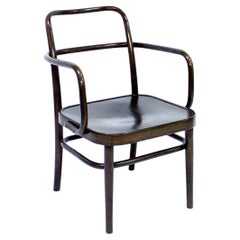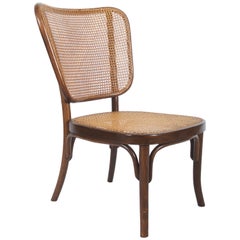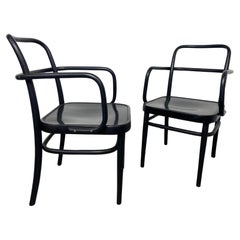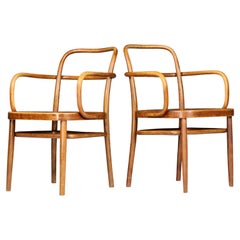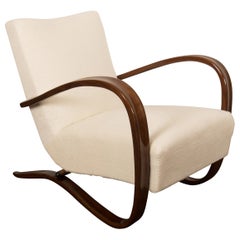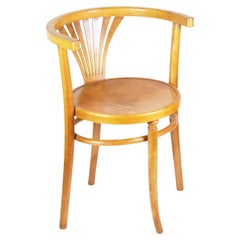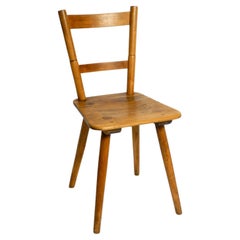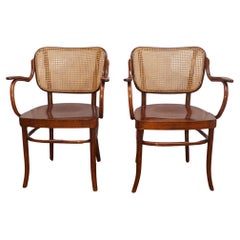Gustav Adolf Schneck Furniture
to
8
8
3
1
8
2
6
5
8
7
6
6
2
8
4
3
1
8
8
8
5
7,546
3,967
2,548
2,244
Creator: Gustav Adolf Schneck
Adolf Schneck, rare A 64 F Bentwood armhair for Thonet, 1929
By Gustav Adolf Schneck, Thonet
Located in Uppsala, SE
Rare armchair by Adolf Schneck (sometimes wrongly attributed to Josef Hoffmann) designed in 1929 and made by Thonet. This model was exhibited at the Viennese Art and Industry show du...
Category
1930s Austrian Bauhaus Vintage Gustav Adolf Schneck Furniture
Materials
Beech, Bentwood
Gustaf Adolf Schneck for Stuhlfabrik Schäfer "Tübingen Chairs " Germany, 1955
By Gustav Adolf Schneck
Located in Almelo, NL
Gustaf Adolf Schneck for Stuhlfabrik Schäfer "Tübingen Chairs " Germany, 1955
The original "Tübingen chairs" was designed by Prof. Gustav Adolf Schneck for Stuhlfabrik Schäfer and...
Category
Mid-20th Century German Mid-Century Modern Gustav Adolf Schneck Furniture
Materials
Beech
Bauhaus Long Chair by Gustav Adolf Schneck for Thonet
By Gustav Adolf Schneck, Gebrüder Thonet Vienna GmbH
Located in Vienna, AT
Beech bentwood with caned seat and backrest, designed by Gustav Adolf Schneck and made by Thonet in the late 1930s. Perfect unrestored original co...
Category
1930s Austrian Bauhaus Vintage Gustav Adolf Schneck Furniture
Materials
Cane, Beech, Bentwood
Art deco armchairs no.A 64F by Adolf Gustav Schneck for Thonet Mundus
By Thonet-Mundus, Gustav Adolf Schneck
Located in Banská Štiavnica, SK
Art deco bentwood armchairs no.A64F by Adolf Gustav Schneck for Thonet Mundus.
Category
1930s Czech Art Deco Vintage Gustav Adolf Schneck Furniture
Materials
Beech, Bentwood
Art deco desk chair A64F by Adolf Gustav Schneck for Thonet Mundus
By Thonet, Gustav Adolf Schneck
Located in Banská Štiavnica, SK
Art deco desk chair A64F by Adolf Gustav Schneck for Thonet Mundus. Professionally stained and repolished with french polish and new leather seat.
Category
1930s Czech Art Deco Vintage Gustav Adolf Schneck Furniture
Materials
Leather, Beech, Bentwood
Bauhaus Armchairs by Adolf Gustav Schneck No. A 64 F Austria 1927
By Gustav Adolf Schneck
Located in Almelo, NL
Armchairs by Adolf Gustav Schneck No. A 64 F Austria 1927.
Beech bentwood armchairs model No. A 64 F was designed by Gustav Adolf Schneck and m...
Category
Early 20th Century Austrian Bauhaus Gustav Adolf Schneck Furniture
Materials
Bentwood, Plywood
Bauhaus Chair Thonet A283 by Gustav Adolf Schneck in 1928
By Gustav Adolf Schneck, Thonet-Mundus
Located in Praha, CZ
Manufactured in Czechoslovakia by the Thonet-Mundus. Designed in year 1928 by prof. Gustav Adolf Schneck. Bent beechwood. New shellac finish.
Category
Early 20th Century Czech Bauhaus Gustav Adolf Schneck Furniture
Materials
Bentwood
Set of 4 chairs model A821 by Adolf Gustav Schneck for Thonet Mundus
By Gustav Adolf Schneck, Thonet-Mundus
Located in Banská Štiavnica, SK
Set of 4 chairs model A821 by Adolf Gustav Schneck for Thonet Mundus. Absolutely original condition, combination of natural rattan weave on the ba...
Category
1930s Czech Art Deco Vintage Gustav Adolf Schneck Furniture
Materials
Rattan, Beech, Bentwood
Related Items
Art Deco Thonet H269 Armchair by Jindrich Halabala
By Gebrüder Thonet Vienna GmbH, Jindřich Halabala
Located in Vienna, AT
Beech bentwood walnut stained armchair made by Thonet in the 1930s.
Excellent restored with seat springs upholstered with Sandra Jordan Prima Alpaca fabric.
Another fabric and wood...
Category
1930s Czech Art Deco Vintage Gustav Adolf Schneck Furniture
Materials
Beech, Bentwood
Office Chair Thonet Nr.28
By Thonet
Located in Praha, CZ
Original state with a pleasant patine of age, perfectly cleaned and re-polished with shelack finish.
We can offer cost-effective shipping.
Category
Early 20th Century Austrian Belle Époque Gustav Adolf Schneck Furniture
Materials
Beech, Bentwood
Art Deco Thonet H269 Armchair by Jindřich Halabala
By Thonet
Located in Vienna, AT
Beech bentwood walnut stained armchair made by Thonet in the 1930s.
Excellent restored with new seat springs upholstered with Lelievre wool fabric.
Another fabric and wood finish o...
Category
1930s Czech Art Deco Vintage Gustav Adolf Schneck Furniture
Materials
Beech, Bentwood
Wooden Armchair Mundus Vienna Style Thonet, 1920's
By Thonet-Mundus
Located in Praha, CZ
- made in Austria
- made of wood
- good, original condition.
Category
1920s Czech Art Nouveau Vintage Gustav Adolf Schneck Furniture
Materials
Wood
Erich Dieckmann Bauhaus Lounge Chair
By Erich Dieckmann
Located in Winter Park, FL
A vintage Art Deco Bauhaus lounge chair by Berlin born designer Erich Dieckmann (1896-1944). Sturdy bent beech wood frame with tightly woven wicker seat and back. Decorative weaving ...
Category
Early 20th Century German Bauhaus Gustav Adolf Schneck Furniture
Materials
Wicker, Beech
Thonet Cane and Black Ebonized Bentwood Chair After Thonet 209
By Thonet
Located in Mombuey, Zamora
The chair after Thonet is from the years between 1950s
This is Le Corbusier's favourite chair and one of the favourite designs of architects and designers.
Unfortunately it has no...
Category
Mid-20th Century Spanish Mid-Century Modern Gustav Adolf Schneck Furniture
Materials
Cane, Bentwood
Jugendstil Armchairs No 714 by Jacob & Josef Kohn Style Otto Wagner Austria 1902
By Jacob & Josef Kohn
Located in Vienna, AT
Jugendstil armchairs model no 714, which were designed Style Otto Wagner, Vienna, 1902 and produced by Jacob & Josef Kohn.
Documented in the company´s catalogue Kohn from 1903.
The chairs were made out of mahogany stained beechwood and shellac hand polished. While the frame was made out of beechwood, the back and seat were made of perforated plywood...
Category
Early 1900s Austrian Jugendstil Antique Gustav Adolf Schneck Furniture
Materials
Plywood, Beech
H 32.28 in W 24.8 in D 21.65 in
Vintage Art Deco Aluminum Swivel Office Desk Chair by Emeco
By Emeco
Located in Los Angeles, CA
Condition: Original Vintage Condition
Materials: Aluminum, Original Black Vinyl Upholstery
Dimensions:
30.50”-33.50"H x 24.50”W x 20”D
Seat Height 20"
A true industrial icon, thi...
Category
1940s American Art Deco Vintage Gustav Adolf Schneck Furniture
Materials
Aluminum
Set of 4 Biedermeier Chairs, South German, 1820
Located in Belmont, MA
This set of 4 Biedermeier chairs dates back to around 1820 and comes from southern Germany. The chairs feature a pretty cherry veneer. The back shows a very unusual interlacing eboni...
Category
1820s German Biedermeier Antique Gustav Adolf Schneck Furniture
Materials
Cherry
4 Black Bentwood & Cane Josef Hoffman Prague 811 Armchairs for Stendig by Thonet
By Josef Hoffmann, Stendig Co., Thonet
Located in Topeka, KS
Iconic vintage Bauhaus black painted bentwood & cane Josef Hoffman Prague 811 armchairs imported by Stendig for Thonet, a set of 4. Beautiful condition, keeping in mind that these are vintage and not new so will have signs of use and wear even if it has been refinished or restored. Specifically, there have been a few small repairs in the caning of all chairs and one chair seat has been replaced completely. It has been replaced with sheet cane and not individually woven. Please see photos, zoom in for details, and see long description as they are part of the condition report. We attempt to portray any imperfections. Circa, Early to Mid-20th Century.
Much like a fine wine or the Mona Lisa, some things just get better with age… That’s just a fact! Including these iconic vintage black painted bentwood & cane Josef Hoffman Prague 811 armchairs by Stendig for Thonet! Talk about the ability to withstand the hands of time!! This Josef Hoffman 811 chair was originally designed in 1925 but remains a current and fabulous design that is highly sought after today. This set of 4 is comprised of beautiful black painted bentwood frames bearing slender rounded arms, slightly flared legs, and marvelous natural cane seats AND backs!! SPECTACULAR!!! Can’t you just SEE these beauties surrounding your kitchen table, breakfast nook, game table, or simply used as extra seating in the family room? We certainly can! Just the right touch of Bauhaus magnificence to any room and they’re sure to complement your home with their classic, historical excellence, whatever your style whether its Bauhaus, Art Deco, Mid-Century Modern, or Modern!!
Josef Hoffman was one of Austria's most important architects and designers and was central to the development of art and design in Vienna. He grew up with three sisters and was nicknamed Pepo. His father was the town mayor and a successful businessman. He was a founding member of the Vienna Secession, a radical anti-historicist movement, and together with Koloman Moser created the Wiener Werkstatte cooperative workshop. A highly individualistic architect and designer, Hoffmann's work combined the simplicity of craft production with a refined aesthetic ornament. Between 1901 and 1905, he designed four villas in Vienna and a sanatorium in Brussels that was called “Stoclet House”, for which he developed a “cubistic” language of form, with an emphasis on straight, unadorned lines. In 1905, he established the Kunstschau with painter Gustav Klimt and, two years later, founded the Deutscher Werkbund. Hoffmann worked well into his 80s, continuing to use the geometric motifs that influenced the art deco style of the 1920s. In 1928 his work appeared in the Art in Industry exhibition held at Macy’s in New York City, where it exerted a strong influence on American designer Donald Deskey. Hoffmann is one of the seminal figures in the modern decorative arts movement of the first half of the 20th century.
Stendig was totally the brainchild and passion of Charles W. Stendig. You cannot write or talk about Stendig without explaining Charles. He was a pioneer of import goods in the mid-century. After serving in WWII as a paratrooper, he studied business with emphasis on international trade at NYU and City College of New York. Afterward first working for Raymor, another pioneering distribution company, for about two years, departing to start his own business: Stendig. He opened his first showroom in 1956 in midtown Manhattan. He is credited for sparking America’s interest in furniture from Finland, Switzerland, Italy, and Czechoslovakia. He imported from the likes of Thonet, Asko, and De Sede; and from iconic designers including Le Corbusier, Josef Hoffmann, Eero Aarnio, Tapio Wirkkala, Marcel Breuer, Jonathan De Pas, Donato D’Urbino, Paolo Lomazzi, Carlo Mollino, Carlo Scarpa, and Pier Giacomo Castiglioni to name just a few. By the late 1960’s, Stendig had showrooms in Chicago, Los Angeles and San Francisco with a large headquarters in NYC. They were exciting and good times but short lived. The business was a challenge and when an offer was made by Burlington Industries to purchase, Charles agreed. He stayed on till 1976 to oversee and then retired. I have searched the internet to no avail to find out if a Stendig division is still in operation. But I can only find the Stendig Calendar, the only calendar in MoMA’s collection, which was designed for Stendig by Mossimo Vignelli, still offered. But I am having a hard time deciding who is creating and offering it. I do know Burlington Industries was bankrupt by 2001, purchased in 2003, merged with Cone Mills in 2004 and subsequently into ITG or International Textile Group. But the Stendig name reins as an icon of high style mid-century offerings.
Thonet was founded by Michael Thonet. Michael was born in 1796 and was apprenticed by his father to a cabinetmaker. Shortly after he married, Michael opened his one-man cabinetmaking shop creating furniture and cabinetry in the traditional manner by carving the needed parts and then joining them together. In 1830 he began experimenting with bending wood into curved shapes and thus began a successful furniture company that has remained continually in operation for nearly 200 years. Thonet’s early work was very Biedermeier in style and not made for the common man. Gradually his designs became more Art Nouveau. In 1951 his chairs for the Crystal Palace at the London World’s Fair won a prize medal and by the late 1950s he began to make his first “consumer” chair. In 1875, a year before Michael’s death, Thonet’s five factories made 620,000 chairs. Then in 1876 after his death the company became Gebruder Thonet. But all was not roses. In 1869 the Thonet patents lapsed and by 1893 there were 52 bentwood companies in Europe. However, Thonet persevered. They branched out. They merged. They added designs by Le Corbusier and Breuer and alternative materials such as tubular chrome in place of bentwood to their offerings. Business boomed and waned through the years and there was even a Thonet revival, so to speak, beginning in the 1940s on into the mid-20th century. Till today, in the 21st century, Thonet is still a furniture company to be reckoned with almost 200 years later.
We are in love with this iconic set of 4 Prague 811 chairs...
Category
Early 20th Century Czech Bauhaus Gustav Adolf Schneck Furniture
Materials
Cane, Bentwood, Paint
H 32 in W 20.75 in D 19 in
Beech Chairs by Adolf Loos for Thonet
By Adolf Loos
Located in Budapest, HU
These armchairs can be attributed to Adolf Loos, following the essay of Giovanni Renzi:
Thonet uses the modern term only once in the 1904 catalog, on what ...
Category
Early 1900s Austrian Jugendstil Antique Gustav Adolf Schneck Furniture
Materials
Leather, Beech
Josef Hoffmann Armchair – Model No. A 811/F for Thonet
By Josef Hoffmann, Thonet
Located in Budapest, HU
Josef Hoffmann Armchair – Model No. A 811/F for Thonet (1900s)
This exquisite armchair, Model No. A 811/F, designed by the renowned architect and designer Josef Hoffmann for Thonet ...
Category
Early 1900s Austrian Art Nouveau Antique Gustav Adolf Schneck Furniture
Materials
Reed, Beech
Previously Available Items
1930s Tübinger chair by the architect Prof. Adolf Gustav Schneck for Schäfer
By Gustav Adolf Schneck
Located in München, DE
Original Tübingen chair from the 1930s by Prof. Adolf Gustav Schneck for Schäfer. Made in Germany.
Seat made of red beech slats. All parts glued and inserted. No metal screws.
The Tübingen chair was produced for decades by the Schäfer chair...
Category
1930s German Mid-Century Modern Vintage Gustav Adolf Schneck Furniture
Materials
Beech
H 33.47 in W 16.54 in D 19.69 in
Pair of Thonet Bentwood Chairs
By Gustav Adolf Schneck, Thonet-Mundus
Located in Hudson, NY
This exquisite pair of Thonet Bentwood Armchairs Model No. NR-283F. Designed in the 1930s by Gustav Adolf Schneck for Thonet-Mundus, the chairs are constructed of bent beechwood and ...
Category
Mid-20th Century German Revival Gustav Adolf Schneck Furniture
Materials
Cane, Bentwood
Pair of Bauhaus Chair Thonet A283 by Gustav Adolf Schneck in 1928
By Gustav Adolf Schneck, Thonet-Mundus
Located in Praha, CZ
Manufactured in Czechoslovakia by the Thonet-Mundus. Designed in year 1930 by prof. Gustav Adolf Schneck. Original state only with minor repairs. Cleaned and gentle re-polished with ...
Category
Early 20th Century Czech Bauhaus Gustav Adolf Schneck Furniture
Materials
Bentwood
Pair of Bauhaus Armchairs Thonet A283-F by Gustav Adolf Schneck in 1930
By Gustav Adolf Schneck, Thonet-Mundus
Located in Praha, CZ
Manufactured in Czechoslovakia by the Thonet-Mundus. Designed in year 1930 by prof. Gustav Adolf Schneck. Bent beechwood. Original state only with minor repairs. Cleaned and gentle r...
Category
Early 20th Century German Bauhaus Gustav Adolf Schneck Furniture
Materials
Bentwood
H 30.71 in W 25.99 in D 23.63 in
Gustav Adolf Schneck furniture for sale on 1stDibs.
Gustav Adolf Schneck furniture are available for sale on 1stDibs. These distinctive items are frequently made of wood and are designed with extraordinary care. There are many options to choose from in our collection of Gustav Adolf Schneck furniture, although brown editions of this piece are particularly popular. Many of the original furniture by Gustav Adolf Schneck were created in the Art Deco style in europe during the 20th century. If you’re looking for additional options, many customers also consider furniture by Hans & Wassili Luckhardt, Slezak Company, and Frank Josef. Prices for Gustav Adolf Schneck furniture can differ depending upon size, time period and other attributes — on 1stDibs, these items begin at $505 and can go as high as $21,016, while a piece like these, on average, fetch $2,450.
